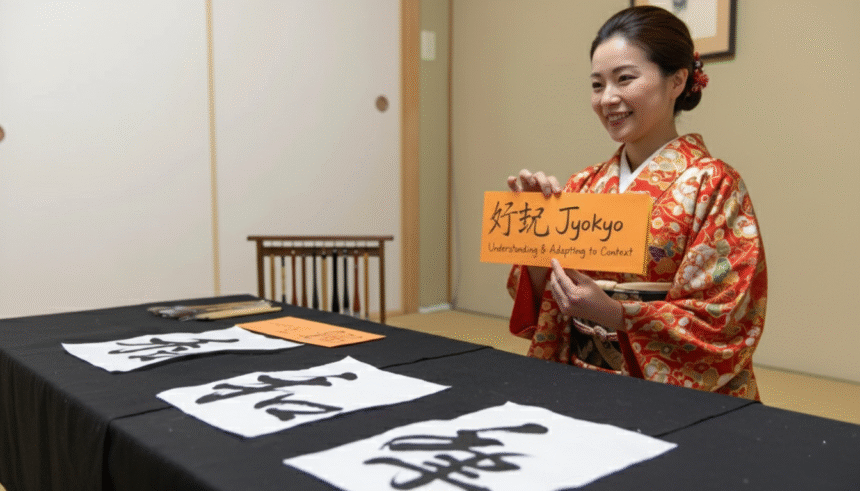Language often carries more than just definitions — it carries culture, philosophy, and ways of seeing the world. One such term that beautifully reflects this idea is “Jyokyo” (状況), a Japanese word often translated as “situation,” “circumstance,” or “context.” But in reality, its meaning goes far deeper than a simple dictionary translation. Jyokyo is not just about describing what’s happening; it’s about understanding, adapting, and responding to the reality around us — a concept deeply woven into Japanese culture, communication, and even spirituality.
In this first part of our in-depth guide, we’ll explore what “Jyokyo” truly means, how it reflects Japan’s cultural values, how it’s used in language and communication, and how it shapes daily life and mindset. By the end of this part, you’ll start to see “Jyokyo” not just as a word — but as a perspective.
What Does Jyokyo Mean? A Deep Linguistic Breakdown
At its most basic, “Jyokyo” (状況) is a combination of two kanji:
-
状 (jō) — meaning “state,” “condition,” or “appearance.”
-
況 (kyō) — meaning “situation,” “circumstance,” or “context.”
Together, they form a term that points not just to the facts of a situation but to the overall state of affairs — including its subtle nuances and underlying context.
In Japanese, words often carry layers of meaning shaped by their cultural and social use. “Jyokyo” is more than just a neutral description of events; it invites you to observe the bigger picture — the visible conditions, the unseen dynamics, and the appropriate actions they call for.
For example, where English might simply say “the situation is difficult,” Japanese speakers often choose phrasing like “Jyokyo ga muzukashii” (状況が難しい) — which carries a softer, more reflective sense of the environment being complex, not just the event itself.
Jyokyo as a Mirror of Japanese Cultural Values
To truly understand “Jyokyo,” we need to look beyond language and into culture. Japanese society places high value on awareness of context — whether in communication, decision-making, or social behavior. This emphasis is rooted in key cultural principles such as:
-
Wa (和) — harmony and balance within a group.
-
Kūki o yomu (空気を読む) — “reading the air,” or sensing the unspoken mood.
-
Tatemae and Honne (建前と本音) — the contrast between public behavior and private feelings.
“Jyokyo” reflects all these values. To act appropriately in Japan often means reading the jyokyo — understanding what’s happening, what’s expected, and how your actions will affect the group.
For instance, in a work setting, a team member might choose not to speak up with a conflicting opinion during a meeting if the jyokyo suggests that harmony and consensus are more important at that moment. It’s not about suppressing oneself — it’s about aligning with the situation.
Jyokyo in Formal and Professional Communication
In professional environments, “Jyokyo” becomes an essential part of communication strategy. It helps determine not only what is said but also how and when it’s said.
Here’s how it often appears in formal contexts:
-
Reporting: “Genzai no jyokyo o hōkoku shimasu” (現在の状況を報告します) — “I will report the current situation.”
-
Problem-solving: “Jyokyo ni oujite kaiketsu o kangaeru” (状況に応じて解決を考える) — “We will consider a solution according to the situation.”
-
Decision-making: “Jyokyo o mite kettei shimashou” (状況を見て決定しましょう) — “Let’s decide after observing the situation.”
In business culture, being aware of and responding to “jyokyo” shows emotional intelligence, professionalism, and respect for context. It signals that decisions are not made impulsively but are grounded in a full understanding of the conditions.
Common Jyokyo Phrases in Professional Contexts
In business and formal communication, certain expressions containing “jyokyo” are frequently used in documents, reports, and meetings. These phrases show how deeply the concept is woven into corporate, political, and public-sector language:
| Phrase | Translation | Usage |
|---|---|---|
| 経営の状況 (Keiei no Jyokyo) | Business conditions | Used in company reports, board reviews, and strategy meetings |
| 緊急状況 (Kinkyuu Jyokyo) | Emergency situation | Referenced in crisis response, disaster planning, and public health updates |
| 市場の状況 (Shijou no Jyokyo) | Market condition | Found in financial news, investor notes, and economic outlooks |
| 雇用の状況 (Koyou no Jyokyo) | Employment conditions | Common in labor statistics, HR reports, and government updates |
| 国際情勢 (Kokusai Jyosei) | International situation | Used in diplomatic statements, political analysis, and global news |
Jyokyo in Daily and Informal Japanese Conversation
Outside the boardroom, “jyokyo” is equally common in everyday speech. Its flexibility allows it to describe anything from social situations to weather conditions, from moods to personal circumstances.
Some examples of how it’s casually used include:
-
“Kono jyokyo de wa ikenai ne.” (この状況ではいけないね。) — “This situation isn’t good.”
-
“Jyokyo ga kawatta.” (状況が変わった。) — “The situation has changed.”
-
“Anata no jyokyo wa dou?” (あなたの状況はどう?) — “How’s your situation?”
What’s noteworthy here is how natural it is for Japanese speakers to refer to context directly in daily life. Whether discussing relationships, work, or even weekend plans, the “situation” is always part of the conversation — reinforcing the idea that context shapes choices.
Jyokyo as a Spiritual and Philosophical Practice
Beyond language and culture, “jyokyo” carries philosophical weight — particularly in its connection to mindfulness and Zen thought. In many ways, being aware of “jyokyo” aligns with the principle of living in the present moment.
In Zen, one learns to observe without judgment, responding to life as it unfolds rather than trying to control or resist it. Similarly, understanding “jyokyo” means accepting the present context fully — whether it’s favorable or challenging — and then acting wisely within it.
This mindset encourages:
-
Adaptability: Adjusting your approach based on current conditions.
-
Acceptance: Recognizing what is, rather than wishing it were different.
-
Awareness: Seeing the broader picture beyond immediate events.
Over time, this way of thinking can transform how one approaches stress, relationships, and decision-making. It’s not just a word — it becomes a practice in perspective.
Testimonials: How Jyokyo Has Changed Lives
Many people who study Japanese language or culture describe encountering “jyokyo” as a turning point — a shift in how they see the world.
-
For expats in Japan, understanding “jyokyo” often marks the moment they start to integrate more smoothly into social and professional environments. They learn not just what to say but when and how to say it.
-
For mindfulness practitioners, “jyokyo” becomes a tool for emotional resilience. Recognizing and adapting to circumstances — rather than fighting them — leads to more balanced, thoughtful responses.
A common reflection is this: “Once I started paying attention to the jyokyo instead of trying to control everything, life felt more fluid. Decisions became clearer, and relationships became easier.”
Dispelling Misconceptions About Jyokyo
Despite its richness, “jyokyo” is sometimes misunderstood — especially by those encountering it for the first time.
Myth 1: Jyokyo is always negative.
While it’s often used to describe challenges (“The situation is difficult”), it’s just as valid for positive circumstances. “Jyokyo ga yoi” (状況が良い) means “The situation is good.”
Myth 2: Jyokyo equals ‘jijō.’
Another term, “jijō” (事情), also means “circumstances,” but it focuses more on personal or internal reasons behind a situation. “Jyokyo,” by contrast, looks outward — at the external state of affairs.
Understanding these distinctions helps avoid confusion and deepens appreciation for how the word is used.
How to Incorporate Jyokyo Into Daily Life
Understanding “jyokyo” as a concept is one thing — but learning how to apply it to everyday life is where its real power lies. The beauty of “jyokyo” is that it’s not limited to language or culture; it’s a practical mindset you can integrate into work, relationships, travel, and even personal growth.
One of the simplest ways to begin is by pausing to assess the situation before responding. Instead of reacting immediately, ask yourself: What is the current jyokyo? What are the visible and invisible dynamics here? This small shift in thinking encourages more thoughtful decisions and reduces misunderstandings.
Here are a few examples of how you can consciously apply “jyokyo” in different contexts:
-
At Work: Before proposing a new idea or change, understand the current priorities, team mood, and leadership direction. Acting with “jyokyo” in mind can make your suggestions more likely to succeed.
-
In Relationships: Pay attention to emotional context. A conversation that might feel harmless to you could land differently depending on the other person’s situation or state of mind.
-
While Traveling: When in a new culture or environment, observing “jyokyo” — social norms, local customs, or unspoken expectations — helps you adapt respectfully and avoid misunderstandings.
This practice is essentially about reading the room, reading the moment, and responding appropriately — a skill that becomes second nature the more you practice it.
Jyokyo and the Digital Era
The digital age has transformed how we communicate, connect, and form relationships — and with it, the importance of understanding “jyokyo” has grown even stronger. Online, context can shift rapidly. A post that feels timely and relevant one day might feel insensitive or outdated the next. Recognizing the digital “jyokyo” is now an essential part of navigating social platforms, online communities, and even remote work environments.
For example, companies that succeed on social media often do so because they understand the situation — they post messages that align with current events, public mood, and social conversations. Similarly, individuals who are aware of the online jyokyo tend to communicate more effectively and avoid unnecessary conflicts.
Some practical ways to apply “jyokyo” in digital spaces include:
-
Before posting: Ask yourself if your message suits the current cultural or social climate.
-
In online debates: Consider the tone and context before responding. Sometimes, silence or empathy is the wisest response.
-
In virtual work: Adapt your communication style to match the mood and expectations of your team — just as you would in a physical meeting room.
In a world where digital missteps can happen quickly and spread widely, the ability to understand and act according to “jyokyo” is a valuable modern skill.
The Future of Jyokyo – A Global Mindfulness Movement?
Although “jyokyo” is deeply rooted in Japanese language and culture, its underlying principles are universal. As global conversations increasingly emphasize emotional intelligence, mindfulness, and contextual awareness, the concept of “jyokyo” is gaining relevance far beyond Japan’s borders.
In cross-cultural communication, for instance, understanding the situational context is vital to building trust and avoiding misinterpretations. In business, leaders who make decisions based on a clear reading of the environment tend to be more effective. Even in personal growth, the practice of observing and responding to circumstances — rather than resisting them — leads to greater resilience and peace of mind.
It’s possible that “jyokyo” will become part of a broader global vocabulary of mindfulness and awareness. Much like words such as “ikigai” (life purpose) or “kaizen” (continuous improvement) have entered global consciousness, “jyokyo” has the potential to inspire people worldwide to live more attentively, adaptively, and harmoniously.
FAQs About Jyokyo
1. Is “jyokyo” only used in formal Japanese?
No. While “jyokyo” is common in business and professional settings, it’s also widely used in everyday conversation to describe all kinds of situations, from personal circumstances to social dynamics.
2. Can “jyokyo” be negative or positive?
Absolutely. “Jyokyo” is neutral — it simply refers to the state of things. It can describe both positive and negative contexts depending on how it’s used.
3. How is “jyokyo” different from “jijō”?
“Jijō” refers more to personal reasons or circumstances behind a situation, while “jyokyo” describes the external state of affairs — the bigger picture.
4. Can I use “jyokyo” outside of Japan?
Yes. Even if you’re not speaking Japanese, adopting the concept of “jyokyo” as a mindset — being aware of and responding appropriately to context — is valuable in any culture or situation.
Conclusion: Embracing Jyokyo as a Way of Life
At first glance, “jyokyo” may seem like a simple translation of the English word “situation.” But as we’ve seen, it’s far more profound than that. It’s a reflection of a culture that values harmony, awareness, and thoughtful action. It’s a linguistic tool that shapes communication and relationships. And most importantly, it’s a mindset — one that invites us to pause, observe, and respond with wisdom and sensitivity.
In a fast-changing world, understanding “jyokyo” is more than a cultural lesson — it’s a guide for living well. By practicing awareness of the situations around us, we not only improve how we communicate and make decisions but also deepen our connection to the people and environments that shape our lives.
“Jyokyo” reminds us that context is everything — and by learning to read it, we learn to live more fully and more harmoniously.
For more quality, informative content, visit writewhiz







